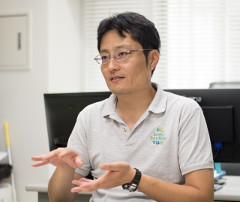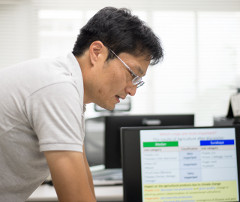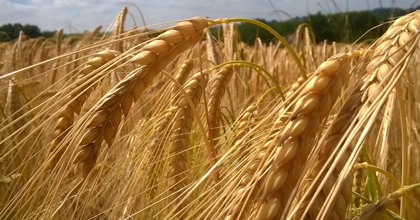The importance of preparing measures to mitigate the effects of global warming and cope with the strain placed on agricultural production

In recent years, extremely high temperatures during summer, localized torrential downpours and guerrilla rainstorms have become progressively common in Japan. It has become widely accepted that these abnormal weather conditions are a result of global warming. At the COP21 (the 21st Conference of the Parties of the United Nations Framework Convention on Climate Change), member countries agreed to a collective goal of keeping projected increases in the average global temperature to well below 2 degrees above pre-industrial levels. This goal, however, will not be easily achieved. The IPCC (the Intergovernmental Panel on Climate Change) has developed four possible climate change scenarios over a roughly 20 year period between 2081 and 2100. The worst-case scenario estimates a 2.6 – 4.8 degree increase in average global temperature compared to the most recent figure (the mean temperature of 1986 – 2005). By comparison, the best-case scenario projects an increase in the range of 0.3 – 1.7 degrees. As the global average temperature increased by 0.61 degrees between the pre-industrial period and 1986, the goal of COP21 will not be achieved unless the best-case scenario of the IPCC is realized. In light of this, the “Paris Agreement” was adopted and efforts have been exerted around the world to reduce greenhouse gas emissions.
In spite of such efforts, however, climate change and abnormal weather conditions have continued, and agricultural production, which is largely dependent on the weather, has been adversely affected. For instance, we frequently hear reports in the mass media that prices for seasonal vegetables are soaring due to poor harvests as a result of abnormal weather. In the summer of 2017, it made headlines that the typhoon that hit Hokkaido seriously damaged potato fields causing the sale of potato chips to be suspended due to a severe shortage of potatoes. Further, in that same year, Koshihikari rice, a product of Uonuma, Niigata, was ranked “A” for the first time after ranking “Special A” for the last 28 consecutive years in rice taste rankings by the Japan Grain Inspection Association. Some argue that this was at least partly attributable to the effects of abnormal weather. With regard to rice, abnormal weather conditions, particularly high temperature, cause rice kernels to be chalky and immature, having a noticeably negative effect on quality and taste. These sorts of issues have been reported all across the nation. It is well known that if high daily average temperatures continue for 10 days after rice comes into ears, the probability that kernels will become chalky and immature rises substantially. To sustain the adequate yields and an acceptable quality of agricultural products necessary to feed the global population, it is urgent to implement measures in the agricultural sector to cope with climate change, in parallel with worldwide measures such as the “Paris Agreement” to mitigate the effects of global warming.
Japan’s measures to cope with the effects on rice production are highly effective
There are several measures that Japan has developed in order to cope with the effects on agricultural production. Taking into account expected effects, expenses and durations, the most suitable measure has been identified. With regard to rice, for example, on which I have expertise, one measure has been to develop heat-resistant varieties. Agricultural experiment stations across the country have already been engaged in the development process and have successfully developed several heat-resistant varieties that still maintain an excellent taste. These include the “Genki Tsukushi” and “Nikomaru” varieties of Fukuoka, the “Sai no Kizuna” variety of Saitama and the “Tsuya Hime” variety of Yamagata. While the improvement of existing varieties is a highly effective measure to cope with climate change, it usually takes up to 10 years or so; a considerable amount of time. Another measure is to modify cultivation practices. In this case, the practice would be to change the timing of transplanting so that earing would not take place during the hottest period of the year. This is generally called delayed transplanting, in which transplanting is carried out in June instead of May, as has been done in the past. The practice of delayed transplanting would not result in any significant differences compared to conventional practices in terms of expenses and time required, and would be effective if the temperature is not as high, as forecasted, when rice come into ear. Another measure is related to the application of fertilizer. It has gradually come to be understood that the occurrence of chalky and immature kernels can be controlled by modifying when and how much fertilizer is applied. The modification of conventional cultivation practices or, in other words, the implementation of coping measures will mitigate or avoid the negative effects of climate changes on rice yield and quality. In Japan, rice fields are almost 100% irrigated. On the other hand, around the globe, approximately 50% of rice fields are irrigated while 25% are rain-fed. Contrary to irrigated farming, which uses water channeled from water sources such as a river, rain-fed farming is totally dependent on rainfall, and as such, abnormal weather conditions can have a devastating impact on yields. As a measure to cope with this harsh reality, the establishment of farms based on irrigation systems would be greatly effective. This, however, would demand a large sum of capital investment, provided that civil engineering works, including the necessary construction of irrigation channel networks.
As discussed above, Japan has developed a great variety of potent measures to effectively cope with climate change that can be reasonably applied to rice production. A mechanism has also been in place in which the results of research conducted at agricultural experiment stations, etc. can be immediately shared with farmers, meaning that farmers are well informed and highly motivated. In contrast, around the world, there are many countries where coping measures have not been well developed. In these countries, local researchers may be desperately conducting research alone while farmers are hardly aware of climate change conditions that could have devastating effects on their livelihoods. Being cognizant of the above, Prime Minister Abe announced at the UN Climate Summit in 2014 that Japan would assist developing countries in this regard with the use of domestic technologies to tackle climate change. I am currently involved in one of these initiated projects.
The project to support activities to mitigate the effects of climate change is currently underway in Indonesia

Indonesia is the most populous country in the Southeast Asia. As it is large in area and has a huge number of small islands within its territory, it is considered very susceptible to the negative effects of climate change. In recent years, Indonesia’s economy has been growing rapidly, and land development, including urban development, has been progressing steadily. Although measures to both cope with and mitigate the effects of climate change should be incorporated into the country’s development programs and plans, relevant actions taken by the Indonesian government to date have been inadequate. Among the projects to assist Indonesia in fighting climate change, I have been involved in the project to develop measures to cope with the negative effects of global warming on rice production. Rice is a staple food in Indonesia with an average annual consumption of 120 – 160 kg per person. This figure is three times that of Japan, which features an average annual consumption of 53 kg per person. The total area utilized for rice production in Indonesia is approximately 13 million hectares compared to 1.5 million hectares in Japan. Considering this, some may assume that Indonesia produces a sufficient quantity of rice for its people, taking into account the total area allocated to rice production. In reality, however, rapid population increases on one side and stagnant rice yields caused by climate change on the other, sometimes requires that the country import rice. Indonesia has encountered a variety of issues in regard to rice production. The project conducts studies with the goal of securing sufficient rice yields (in other words, sufficient food) in the future, and assesses the effects of climate change on rice production with projections on future rice yields and kernel quality. Based on study results, the project develops measures to be proposed to the Indonesian government with the objective of mainstreaming these developed measures into government implemented development programs. During a visit to rural areas in Indonesia, I listened to old farmers say that squalls had become erratic, unlike in their childhood when they were regular and predictable. As a result, according to the farmers, the management of water, as well as farm production, has become more difficult. While they complain, they do not seem nearly as concerned about climate change as they should be. In Indonesia, farmers carefully grow traditional local rice varieties that are used as offerings in festivals and ceremonies. If, in the future, farmers become unable to grow traditional local rice varieties due to climate change, the customs and traditional cultures of these areas may be abandoned. Although this scenario may be a bit of an exaggeration, to prevent such a scenario from becoming reality, Indonesia should develop effective measures for rice production and enhance its preparedness.
Globalization has been progressing. This phenomenon has had a number of apparent effects on agriculture. The importation and exportation of a variety of agricultural products directly affects the economy of a country as well as the maintenance of a stable supply of essential foods across the globe. If some country or region experiences a crop failure, it will have knock-on effects that could possibly cause a panic around the world. Two great examples of this would include the drought that hit Australia in 2006 and the drought that hit India in 2009. Consequently, Australia imported wheat, and India imported rice as an emergency measure due to very poor harvests of these products. The rate of food self-sufficiency in Japan is extremely low compared to that of the other developed countries; a mere 38%. This means that crop failures in other countries would have a direct impact on Japan. Further, approximately 800 million people across the world are malnourished due to food shortages. To improve this unfortunate situation, it is very important to disseminate Japan’s highly effective anti-climate change technologies, with proper respect being given to the culture and life style of the recipient country.
Increasing worldwide attention to the provision of agricultural support for developing countries
The idea of assisting developing countries in this regard does not originate in Japan alone. The CGIAR (Consultative Group on International Agricultural Research), which was established in 1971 with the support of the World Bank, the UN Food and Agriculture Organization, and others, has been implementing various activities to improve productivity and develop technologies in the agricultural, forestry and fishery industries of developing countries. The IRRI (International Rice Research Institute), situated in the Philippines, is a major player in the development of rice technologies. More recently, the Bill & Melinda Gates Foundation, the Ford Foundation, and others, have been providing financial assistance for these activities. In 2012, the United Nations developed the 17 SDGs (Sustainable Development Goals), one of which includes measures against climate change. Further, major air conditioning and food companies in Japan have been carrying out activities that have contributed to attainment of these goals. Our university has been also been vigorously engaged in activities related to the SDGs, which include the organization of the world’s first student photo contest under the theme of SDGs.
It may be difficult for most Japanese to be directly involved in agricultural activities overseas. However, I hope that they will pay more attention to issues centering around agriculture, as well as global trends in the fight against global warming, thereby initiating actions such as energy conservation that they can implement on their own.
* The information contained herein is current as of July 2018.
* The contents of articles on Meiji.net are based on the personal ideas and opinions of the author and do not indicate the official opinion of Meiji University.
Information noted in the articles and videos, such as positions and affiliations, are current at the time of production.


